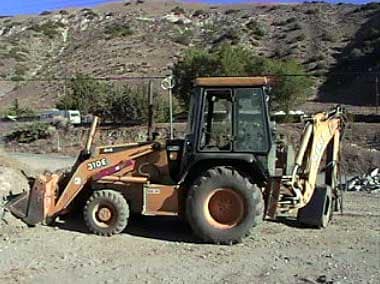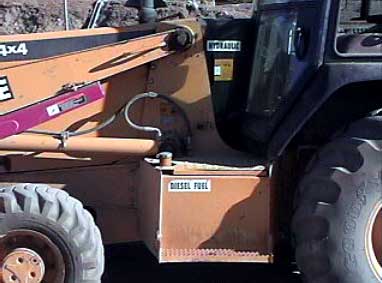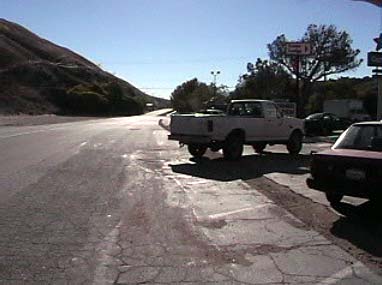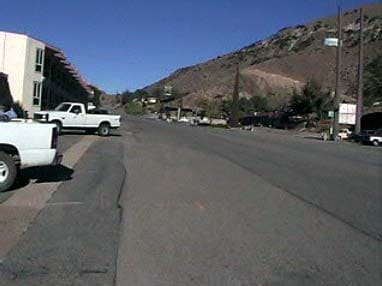A Truck Driver Died When He Fell Off Of and Was Run Over by the Backhoe He Was Riding On
California FACE Report #02CA006
SUMMARY
A 37-year-old truck driver died when run over by a backhoe at a road construction site. He was riding on the backhoe by standing on the backhoe step and holding onto the handrail. The backhoe operator saw the victim and assumed he was on when he started backing. The operator looked over his right shoulder and traveled approximately 10 feet before running over the victim. The CA/FACE investigator determined that, in order to prevent future occurrences, employers, as part of their Injury and Illness Prevention Program (IIPP) should:
- Develop, implement and enforce a policy that clearly states no riders are allowed on backhoes.
- Install safety-warning labels on backhoes that clearly state that riders are prohibited.
INTRODUCTION
On August 9, 2002, at approximately 3:00 p.m., a 37-year-old truck driver was killed when he fell off a backhoe he was riding on and was run over by the left front tire. The CA/FACE investigator learned of this incident on August 22, 2002, through the Legal Unit of the Division of Occupational Safety and Health (Cal/OSHA). On September 19, 2002, the CA/FACE investigator traveled to the victim’s place of employment where he interviewed the supervisor and the backhoe operator. He then traveled to the incident scene and took pictures of the site and the backhoe.
The employer of the victim was a plumbing contractor that had been in business for over 25 years and had locations throughout many counties. The company had approximately 70 employees. The victim had been employed with the company for 20 years. The company had been at the incident site for 14 days and had 6 employees on site when the incident occurred.
The employer of the victim had a written safety program but it was not available at the victim’s work site. There was a written code of safe practices available at the site where the victim worked. Safety meetings were held monthly and were mostly supervisor lectures. The company had a training program at the main office. Training was usually accomplished through on-the-job-training (OJT). The victim and backhoe operator had attending safety meetings where the employer discussed backhoe safety. There was a clear policy that no riders were allowed, however, enforcement of the policy was not consistent.
INVESTIGATION
The site of the incident was a road construction site. A 12-inch water line was being installed in an open trench on a two-lane road adjacent to a fast food restaurant and motel. On the day of the incident, the victim arrived at the incident site with a truck full of gravel and dumped the gravel near the open trench. He was then instructed by his supervisor to grab a shovel and help spread the gravel. After the gravel was spread, the supervisor instructed the backhoe operator to go get some base (dirt and sand mixture), which was about 500 feet away at the end of the trench. The supervisor also instructed the victim to retrieve the water truck, which was in the same area as the base. The victim decided to hitch a ride on the backhoe since it was going in the same direction.
The backhoe operator got into the cab of the backhoe and started it up. Just as he was ready to move the tractor backwards, he noticed the victim jump on the step on the left side of the backhoe. He saw the victim grab the handrail and assumed he was on the backhoe. He looked over his right shoulder and started backing up. After traveling about 10 feet, the backhoe operator felt a bump and turned to see what it was. At that time he realized the victim had fallen off the tractor and that he had run over him.
The supervisor was applying tape to the newly installed pipe in the trench when he heard the backhoe operator yell for him. When the supervisor realized what happened, he told the backhoe operator to call 911. The paramedics and ambulance responded and transported the victim to the nearest hospital. While being transported the victim was pronounced dead.
CAUSE OF DEATH
The cause of death, according to the death certificate was multiple blunt force injuries.
RECOMMENDATIONS / DISCUSSION
Recommendation #1: Develop, implement and enforce a policy that clearly states no riders are allowed on backhoes.
Discussion: Backhoes are designed for one operator with one set of controls and do not have passenger seats. The step and handrail that the victim used to hitch a ride on the backhoe was designed for the operator to enter and exit the tractor and not intended for riders. Operators of backhoes need to not only demonstrate their ability to operate the controls and movement of the tractor, they also need to demonstrate their knowledge of the safety precautions needed to be taken when operating. One vital point of backhoe operation is not allowing an unsafe practice to occur because “everybody else does it”. Employers can ensure safe work practices by establishing work procedures through programs of training, supervision, safe work recognition, and progressive disciplinary measures.
Recommendation #2: Install safety-warning labels on backhoes that clearly state that riders are prohibited.
Discussion: Sometimes it might be necessary to use visual signs to remind employees of their responsibility when it comes to safety. Posting signs on the backhoes that literally state “NO RIDERS” can alert a possible rider of the imminent danger and might prevent a similar occurrence.
References:
- California Code of Regulations, Vol. 9, Title 8, Sections 1510 (b), 3650 (s) (3)
- Association of Equipment Manufactures SAFETY MANUAL, Backhoe/Loader, 1975, rev.2/89
FATALITY ASSESSMENT AND CONTROL EVALUATION PROGRAM
The California Department of Health Services, in cooperation with the California Public Health Institute, and the National Institute for Occupational Safety and Health (NIOSH), conducts investigations on work-related fatalities. The goal of this program, known as the California Fatality Assessment and Control Evaluation (CA/FACE), is to prevent fatal work injuries in the future. CA/FACE aims to achieve this goal by studying the work environment, the worker, the task the worker was performing, the tools the worker was using, the energy exchange resulting in fatal injury, and the role of management in controlling how these factors interact.
NIOSH funded state-based FACE programs include: Alaska, California, Iowa, Kentucky, Massachusetts, Michigan, Minnesota, Nebraska, New Jersey, New York, Oklahoma, Oregon, Washington, West Virginia, and Wisconsin.
To contact California State FACE program personnel regarding State-based FACE reports, please use information listed on the Contact Sheet on the NIOSH FACE website. Please contact In-house FACE program personnel regarding In-house FACE reports and to gain assistance when State-FACE program personnel cannot be reached.
EXHIBITS:

Exhibit #1
View of the backhoe involved in the incident

Exhibit #2
Close-up view of the step and handrail used by the victim.

Exhibit #3
View of the incident scene looking south.

Exhibit #4
View of the incident scene looking north.
